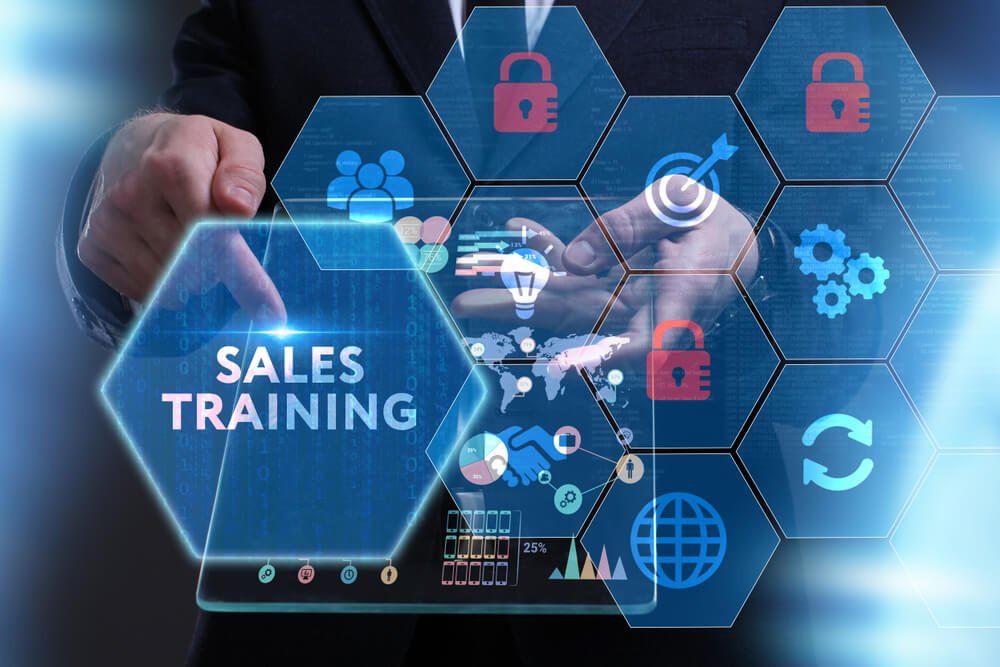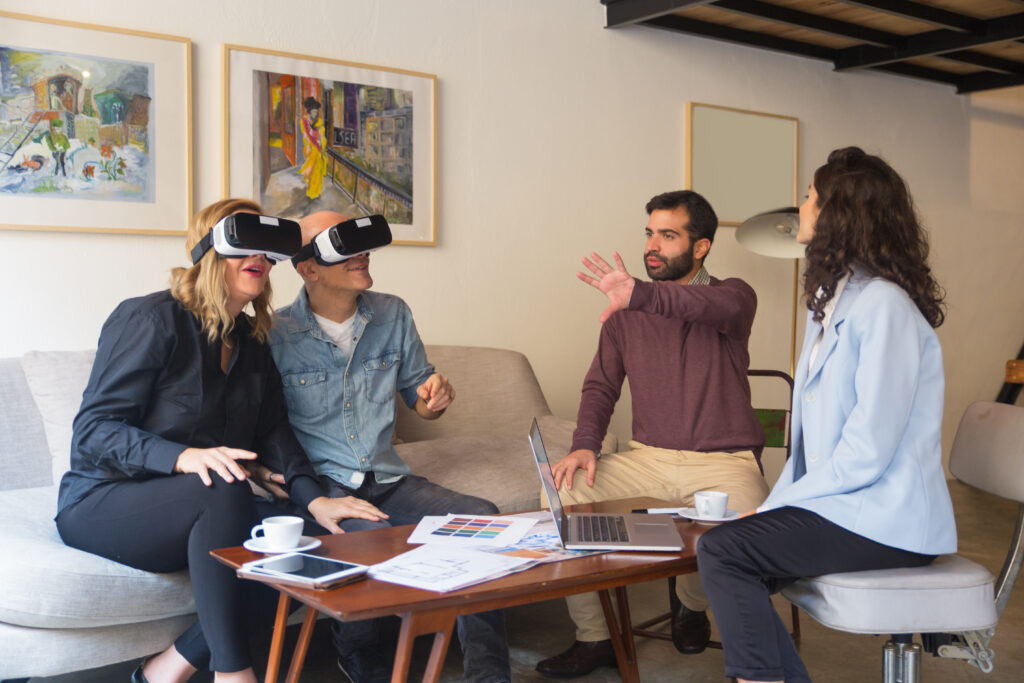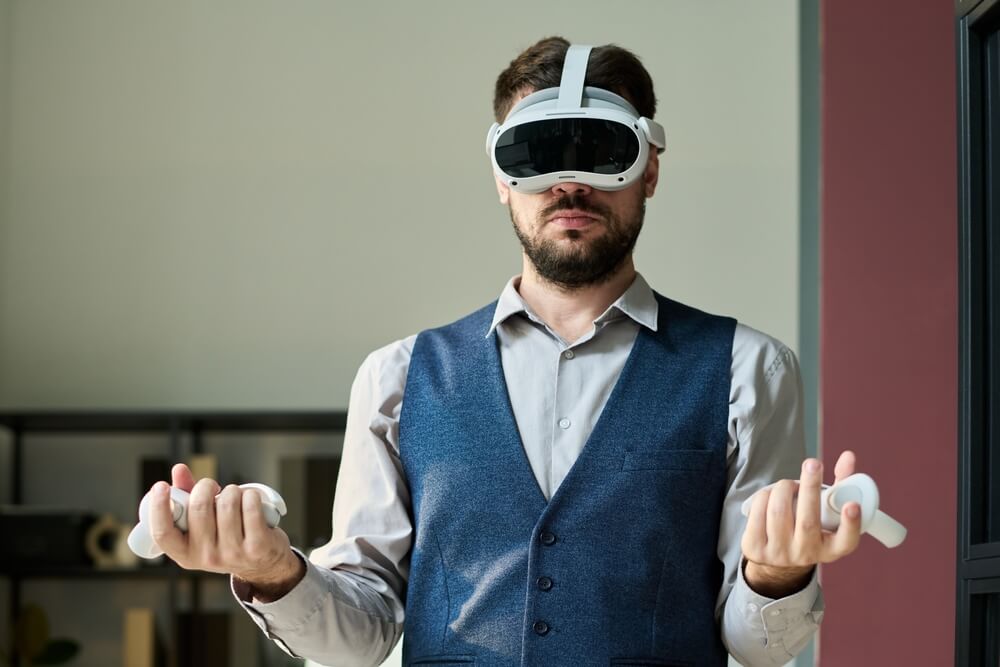Sales training in Virtual Reality
Table of Contents:
Virtual Reality has been of real benefit to the business world over the last few years, and it is now present in every area of our lives, so it should come as no surprise that VR in sales training is becoming increasingly popular. Most experts agree that Virtual Reality has the potential to change sales training as we know it. It helps managers lead their teams and at the same time enhances the performance of salespeople. With the use of sales team training VR, you can simulate a wide variety of events in a risk-free environment. In this article, you will learn how VR can help improve sales efficiency.
Training salespeople in VR – how to do it well
Although it might not be easy to create an engaging sales training experience, it can be extremely profitable. Some research has shown that almost 60% of buyers report that sales representatives cannot answer their questions effectively. This is an unfortunate situation, but in most cases it’s not their fault. Many salespeople are not provided with an effective onboarding or training program and are not properly prepared as a result. So, can VR help companies to train salespeople? Firstly, it is a great way to create an interactive training experience. Participants stay engaged more easily and most distractions are eliminated. The VR sales training experience is immersive and more realistic than practicing with another participant or in front of the mirror. Therefore, salespeople can improve faster and more efficiently, and their sales pitching skills can grow and develop with the use of realistic VR environments and audiences.
Training salespeople in VR – what does it involve?
VR in sales training is like online learning, but it is done differently. Such training combines online learning with Virtual Reality for a unique approach. Participants take part in online classes with a series of videos, case studies, and quizzes, all through the latest VR platforms. Unlike conventional classroom training, the classes are available to access at any time, so sales team training VR is extremely convenient. After taking the online courses, staff can practice what they have learned in realistic Virtual Reality scenarios, so that they keep improving. This continued development is aided by the feedback they receive on their performance, which aims to identify the areas they need to work on to become effective at sales pitching. Some examples of the VR sales training experience are:
- Practicing a sales pitch – participants improve their sales pitch in front of potential buyers.
- Pitching at a trade show – an exhibition simulation where salespeople can practice selling to potential customers.
- Body language – participants practice active listening, eye contact etc.
- Prospect meetings – participants practice meeting new sales prospects for the first time and answering their questions about the product.
- Active listening exercises.
Unlock the future with Mazer: Your innovation partner.
VR in sales training – why is it worth trying out?
Training salespeople in VR is highly effective and beneficial for companies. It prepares staff to deliver engaging and effective sales pitches that really drive results. After a VR course, the participants are armed with the top techniques to persuade potential clients to purchase. They learn how to build chemistry and authentic connections with prospective buyers. On top of this, participants are taught how to present themselves with confidence and clarity. They can easily handle objections and use them to negotiate a winning deal. Below, you will find some more detailed information about how VR sales training experiences can be beneficial.
Creating familiarity
Virtual Reality is a method for creating an interactive training experience. Sales representatives can access numerous simulations where they have the opportunity to practice sales pitches in realistic scenarios. On top of this, the environments are 100% risk-free. Training salespeople in VR creates full familiarity – your reps can even learn how to maintain eye contact and practice using good body language and other essential selling skills in a realistic environment. There are hundreds of virtual potential clients to practice with. The salesperson can test out different reactions and learn to act naturally and feel confident while talking to different types of customers. As salespeople go through a wide variety of scenarios, they have the chance to learn faster than during standard training. Virtual Reality in sales training prepares them for what they will encounter in the real world.
Building empathy
As well as improving sales pitches, every sales representative who participates in VR sales training has the chance to play the role of a potential customer, which is how empathy is built. Once in a customer’s shoes, the salesperson can better understand what they are thinking and feeling. They identify more with their customers, which brings their comfort and self-esteem to a higher level. Therefore, their customer service improves, and their relationships with their customers are much more positive. This means that training salespeople in VR improves both business and soft skills. It offers a safe space for employees to practice and learn from experience. Empathy – feeling what another person feels – can be improved through hard work, and Virtual Reality is definitely relevant here. It supports emotional empathy, and this creates the motivation to learn and upskill. On top of empathy, a sales representative also gains skills like public speaking, negotiation, and networking to name but a few. VR training endows the participant with the sense of having behaved in new ways in real life.
Read also about: VR in empathy training.
Teaching conflict resolution
Virtual Reality can be used for diversity, agreement, and inclusion training. Virtual Reality simulations can replicate scenarios involving issues such as diversity and inclusion, which have become a focus area for many companies. VR can even be implemented in harassment training. It prepares users for conflicts, risks, and high-stakes situations. And all while reducing the risk to the trainees – VR removes the need to imagine a conflict or a difficult situation and instead replaces it with a realistic and safe simulation. Participants gain an effective learning experience in the most realistic way possible. VR training can be hosted in the environment of your choice, for example a store, office, or even in the street. Conflict situations that could negatively affect sales outcomes, such as an argument between a customer and the sales representative, can be fully simulated, which ultimately teaches them how to behave and manage such a crisis.
VR training for sales teams saves you time and money
VR in sales training is also a very cost-effective solution. Participants can learn one-to-one, and everyone learns at the same time. Sales training is even more fun and entertaining. On top of this, while many companies often struggle to find time to train their sales teams, VR is a way to create virtual sessions whenever a particular group of participants is ready and has the time. Training salespeople in VR feels like it’s happening face to face, and it can take place more often, providing greater regularity and more consistent results. And there’s no need to organize training far away from the company, provide accommodation, or pay travel costs. The VR sales training experience is cheaper and more effective than regular training. Of course, there are initial costs if a company wants to invest in VR hardware and software on their own, but these costs will quickly be offset by the money saved through training in this way. It is also possible to rent VR equipment for training purposes or hire an external company or agency that is experienced in providing sales training in VR. Virtual Reality is certainly something you should consider if you want to optimize costs and time while still providing your sales teams with regular sales training of the highest level. Training salespeople without having to leave the office, practicing demonstrating a product, or conducting negotiations with virtual clients can all be done before it happens in the real world. This is achievable with VR in sales training!
Summary
Virtual Reality is clearly something that can help staff deliver more successful sales pitches. It has played a significant role in sales training, and this trend is showing no signs of stopping. VR training for sales teams is dynamic and immersive, and vastly more successful than learning content from a slide presentation or a training manual. With all these benefits, it is likely to become the sales training method of choice in the near future.
How can Virtual Reality enhance sales training?
Virtual Reality (VR) in sales training offers an immersive and risk-free environment, allowing participants to simulate various scenarios. This enhances engagement, eliminates distractions, and accelerates the improvement of sales pitching skills in realistic VR environments.
What does VR in sales training involve?
VR in sales training combines online learning with VR platforms, providing participants with online classes, videos, case studies, and quizzes. After online courses, participants practice in realistic VR scenarios to enhance skills.
What cost and time benefits does VR in sales training offer?
VR in sales training is cost-effective, enabling one-to-one learning and simultaneous training for all participants. It provides an entertaining and flexible learning environment, saving time and money compared to traditional training methods.
Unlock the future with Mazer: Your innovation partner.

Author: Rafał Siejca
Rafal has over twenty years of corporate experience, including roles at Millennium Bank, Comarch, and leading software teams at PZU, one of Europe’s largest insurance companies. As one of Poland’s few true VR experts with a decade of experience, he ensures timely, high-quality project delivery as CEO and CTO.










